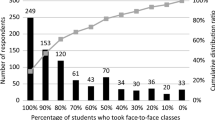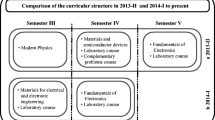Abstract
The use of technology and learner autonomy are two key issues in English for Specific Purposes (ESP) programs. This study aimed to investigate Iranian medical students’ readiness to do ESP tasks based on five situations and discover their reasons for choosing each of the situations. Two of the situations (1 and 2) embodied a conventional autonomous learning process, two (3 and 4) represented a technology-mediated autonomous learning process, and one (5) was based on a self-study method. Data were collected by means of a questionnaire and semi-structured interviews. The results showed that the students’ choices of the situations in order of priority were situation 2, situation 3, situation 1, situation 5, and situation 4. The themes emerging from the content analysis of the students’ reasons for choosing each of the situations were: Situation 1: concentration, individuality gains, professor, group work problems, and learning gains; Situation 2: professor, information exchange, learning gains, personal contact gains, motivation, confidence, discipline, and Internet problems; Situation 3: professor, information exchange, learning gains, time management, accessibility, face-to-face contact demerits, and discipline; Situation 4: stress free, time and language problems; and Situation 5: concentration, individuality gains, time, and university problems. The study concludes that the majority of the students have a low level of readiness for technology-mediated autonomous learning situations. It suggests that the students’ autonomy be promoted through raising their awareness about, motivation for and confidence in using technology for educational purposes and creating incentives for ESP teachers to foster technology-mediated autonomous learning.
Similar content being viewed by others
Explore related subjects
Discover the latest articles, news and stories from top researchers in related subjects.Data availability
The data that support the findings of this study are available from the corresponding author upon reasonable request.
References
Ahmadi, R. (2012). Iranian ESP learners’ perceptions of autonomy in language learning. International Journal of Applied Linguistics & English Literature, 2(1), 28–34.
Ajideh, P. (2009). Autonomous learning and metacognitive strategies essentials in ESP class. English Language Teaching, 2(1), 162–168.
Amiri, M. (2000). A study on the English language programs at B.A. level at Tehran universities. Master’s thesis, Allameh Tabatabai University, Tehran, Iran.
Anaraki, N. L., & Babalhavaeji, F. (2013). Investigating the awareness and ability of medical students in using electronic resources of the integrated digital library portal of Iran: A comparative study. The Electronic Library, 31(1), 70–83.
Arnَ-Macià, E. (2012). The role of Technology in Teaching Languages for specific purposes courses. The Modern Language Journal, 96(Focus Issue), 89–104.
Benson, P. (2001). Teaching and researching autonomy in language learning. London: Longman.
Berge, Z. (1998). Barriers to online teaching in post-secondary institutions: Can policy changes fix it? Online Journal of Distance Learning Administration, 2(1), 1–22.
Bruce, B. (1993). Innovation and social change. In B. Bruce, J. K. Peyton, & T. Batson (Eds.), Network-based classrooms: Promises and realities (pp. 9–32). Cambridge: Cambridge University Press.
Bulter-Pascoe, M. E. (2009). English for specific purposes (ESP), innovation, and technology. English education and ESP, 1–15.
Candy, P. (1991). Self-direction for lifelong learning. California: Jossey-Bass.
Chan, V. (2010). Readiness for learner autonomy: What do our learners tell us? Teaching in Higher Education, 6(4), 505–518. https://doi.org/10.1080/13562510120078045.
Cotterall, S. (1995). Readiness for autonomy: Investigating learner beliefs. System, 23(2), 195–205.
Cotterall, S. (2000). Promoting learner autonomy through the curriculum: Principles for designing language courses. ELT Journal, 54(2), 109–117.
DeJonckheere, M., & Vaughn, L. M. (2019). Semistructured interviewing in primary care research: A balance of relationship and rigour. Family Medicine and Community Health, 7, e000057. https://doi.org/10.1136/fmch-2018-000057.
Dörnyei, Z. (2010). Questionnaires in second language research: Construction, administration, and processing (2nd ed.). London: Routledge.
Dornyei, Z., & Taguchi, T. (2009). Questionnaires in second language research: Construction, administration, and processing. New York: Routledge.
Dukić, D. (2013). Online databases as research support and the role of librarians in their promotion: The case of Croatia. Library Collections, Acquisitions, and Technical Services, 37(1–2), 56–65.
Eslami, R. Z. (2010). Teachers’ voice vs. students’ voice: A needs analysis approach to English for academic purposes (EAP) in Iran academic purposes (EAP) in Iran. English Language Teaching, 3(1), 3–11.
Felix, U. (2005). E-learning pedagogy in the third millennium: The need for combining social and cognitive constructivist approaches. ReCALL, 17(1), 85–100.
Ghoreishi, M., Nadi, M. A., Manshee, G., & Saeedian, N. A. (2017). Thematic analysis of the conceptual framework of E-learning in higher education. Interdiscip J Virtual Learn Med Sci, 8(1), e11498.
Graneheim, U. H., & Lundman, B. (2004). Qualitative content analysis in nursing research: Concepts, procedures and measures to achieve trustworthiness. Nurse Education Today, 24, 105–112.
Grbich, C. (2007). Qualitative data analysis: An introduction. London: SAGE Publications.
Hashemi, M., & Azizinezhad, M. (2011). Computer assisted language learning freedom or submission to machines? Procedia-Social and Behavioral Sciences, 28, 832–835.
Holec, H. (1981). Autonomy and foreign language learning. Oxford: Pergamon.
Horváthová, B. (2011). Development of competences of the autonomous student in professional language teaching through e-learning. XLinguae.eu: A Trimestral European. Scientific Language Review, 3(1), 27–33.
Hsieh, H., & Shannon, S. (2005). Three approaches to qualitative content analysis. Qualitative Health Research, 15, 1–15.
Jafari, S., Ketabi, S., & Tavakoli, M. (2017). Advanced and intermediate EFL learners’ perceptions and practices of autonomous learning. ITL - International Journal of Applied Linguistics, 168(1), 70–90.
Jiménez-Crespo, M. Á. (2014). Building from the ground up: On the necessity of using translation competence models in planning and evaluating translation and interpreting programs. Cuadernos de ALDEEU, 25, 37–67.
Johnson, B. R., Onwuegbuzie, A. J., & Turner, L. A. (2007). Toward a definition of mixed methods research. Journal of Mixed Methods Research, 1, 112–133. https://doi.org/10.1177/1558689806298224.
Kern, N. (2013). Technology-integrated English for specific purposes lessons: Real-life language, tasks, and tools for professionals. In G. Motteram (Ed.), Innovations in learning technologies for English language teaching (pp. 87–116). London: The British Council.
Khoramshahi, E. (2015). A needs analysis study on the curriculum of simultaneous interpretation major in applied-scientific comprehensive university. Master’s thesis. Islamic Azad University, Saveh-Science and Research Branch. Saveh, Iran.
Kirtman, L. (2009). Online versus in-class courses: An examination of differences in learning outcomes. Issues in teacher education, 18(2), 103–116.
Koch, T. (1995). Interpretive approaches in nursing research: The influence of Husserl and Heidegger. Journal of Advanced Nursing, 21, 827–836.
Levy, M. (2009). Technologies in use for second language learning. The Modern Language Journal, 93(Supplements 1), 769–782.
Lincoln, Y. S., & Guba, E.G. (1985). Naturalistic Inquiry. Beverly Hills, CA: Sage Publications.
Little, D. (1991). Learner autonomy. 1: Definitions, issues and problems. Dublin: Authentik.
Little, D. (1996). Freedom to learn and compulsion to interact: promoting learner autonomy through the use of information systems and information technologies. In R. Pemberton, S. L. Edward, W. W. F. Or, & H. D. Pierson (Eds.), Taking control: Autonomy in language learning (pp. 203–219). Hong Kong: Hong Kong University Press.
Littlewood, W. (1996). “Autonomy”: An anatomy and a framework. System., 2(4), 427–435.
Littlewood, W. (1999). Defining and developing autonomy in east Asian contexts. Applied Linguistics, 20(1), 71–94.
Locke, L. (1989). Qualitative research as a form of scientific inquiry in sport and physical education. Research Quarterly for Exercise and Sport, 60(1), 1–20.
Luzَn-Marco, M. J., & Gonzàlez-Pueyo, M. I. (2006). Using the internet to promote autonomous learning in ESP. In E. Arnَ, A. Soler, & C. Rueda (Eds.), Information Technology in Languages for specific purposes: Issues and prospects (pp. 177–190). New York: Springer.
Malekan, F., & Hajimohammadi, R. (2017). The relationship between Iranian ESP learners’ translation ability and resilience in Reading comprehension. International Journal of Education and Literacy Studies, 5(2), 47–52.
Manda, P. A (2005). Electronic resource usage in academic and research institutions in Tanzania. Information Development, 21, (4): 269–282.
Moore, M. (2007). Handbook of distance education. London: Taylor & Frances.
Navidinia, H., Zare Bidaki, M., & Hekmati, N. (2016). Incorporating E-learning in teaching English language to medical students: Exploring its potential contributions. Medical Journal of the Islamic Republic of Iran (MJIRI), 30(1), 1195–1201.
Oxford, R. L. (2008). Hero with a thousand faces: Learner autonomy, learning strategies and learning tactics in independent language learning. In S. Hurd & T. Lewis (Eds.), Language learning strategies in independent settings (pp. 41–63). Bristol: Multilingual Matters.
Reinders, H. (2010). Towards a classroom pedagogy for learner autonomy: A framework of independent language learning skills. Australian Journal of Teacher Education, 35(5), 40–55.
Saffarzadeh, T. (1981). An introduction to the English books published by SAMT. Tehran: SAMT Publications.
Scharle, A., & Szabo, A. (2000). Learner autonomy: A guide to developing learner responsibility. Cambridge: Cambridge University Press.
Schmenk, B. (2005). Globalizing learner autonomy. TESOL Quarterly, 39(1), 107–118.
Schoonenboom, J., & Johnson, R. B. (2017). How to construct a mixed methods research design. Kolner Zeitschrift fur Soziologie und Sozialpsychologie, 69(Suppl 2), 107–131. https://doi.org/10.1007/s11577-017-0454-1.
Spratt, M., Humphreys, G., & Chan, V. (2002). Autonomy and motivation: Which comes first? Language Teaching Research, 6(3), 245–266.
Vygotsky, L. S. (1978). Mind in society. Cambridge: Harvard University Press.
Wenden, A. (1995). Learner training in context: A knowledge-based approach. System, 3, 83–194.
White, C. (1995). Autonomy and strategy use in distance foreign language learning: Research findings. System, 23(2), 207–221.
Zabed, A. S. M. (2013). Use of electronic resources by the faculty members in diverse public universities in Bangladesh. The Electronic Library, 31(3), 290–312.
Zehry, K., Halder, N., & Theodosiou, L. (2011). E-learning in medical education in the United Kingdom. Procedia Social and Behavioral Sciences, 15(1), 3163–3167.
Zhong, Y. (2008). A study of Autonomy English Learning on the Internet. English Language Teaching, 1(2), 147–150.
Acknowledgements
The authors thank all professors and students at Guilan University of Medical Sciences who contributed to the completion of this research project. They specially thank the Deputy for Research and Technology of the university.
Author information
Authors and Affiliations
Corresponding author
Additional information
Publisher’s note
Springer Nature remains neutral with regard to jurisdictional claims in published maps and institutional affiliations.
Rights and permissions
About this article
Cite this article
Alizadeh, I., Ebrahimi, F. Investigating medical students’ readiness for technology-mediated autonomous learning situations in ESP programs. Educ Inf Technol 24, 3289–3309 (2019). https://doi.org/10.1007/s10639-019-09929-9
Received:
Accepted:
Published:
Issue Date:
DOI: https://doi.org/10.1007/s10639-019-09929-9




